

SUUNTOブログ

How to bring mindfulness to the trail
© Sven Musica
With her mother, father, and aunt all distance runners, it was inevitable Meg MacKenzie would follow suit. She grew up on a farm, and enjoyed cross-country through her school years. When she was 25, and without training, she came second in the Three Cranes Challenge stage race, and was first in her age group. “From there I started thinking about trail running more seriously,” she says.
She began working with a coach, got sponsorships and has since had a string of podium and first place finishes in stage and trail running races. Her specialty is mid-distance racing.“I don't know what it is but I keep entering those shorter, sharper races,” she says. “You can race more if you do the 30 k to 40 k distance. And I love racing. That's part of why I do it. I crave competition.”Meg also coaches other runners to reach their dreams. She practices meditation daily and uses mindfulness in her approach to life and coaching. “I've had a lot of experience in the trail running community and “I can see that women in particular struggle to get started, and if they do get started they struggle to maintain what they're doing,” Meg says. “That spurred me to help people, particularly female runners.”Many trail runners rely solely on mental toughness to push themselves, but there are other ways of approaching training and racing. “Listen to your body and really try to get a mind-body connection going because that's the most important connection you can have. Pushing through isn't always the best option.”
Meg's three tips for bringing mindfulness to the trail:
Create your context for each training session
By consciously determining what you want to get out of each session, you will avoid tumbling along in an unconscious blur of day-to-day slog. It takes five minutes, and when you get better at it, one minute. Before you step out the door ask yourself what you want to get out of the next few hours. Maybe it’s an escape after a long day. Maybe you want to learn more about your downhill running. Perhaps you need to relax and take it easy. Or maybe you want to consciously push yourself to the correct splits and times you laid out for yourself. Whatever it is, take a quiet moment to determine it consciously before you set off.
Forgive yourself
Forgive yourself for any training or racing that didn't go how you wantedAcknowledge what happened, give up the resistance to what happened, let go – it creates freedom. And make a decision to move forward. This will allow for more flow and energy rather than getting stuck in one off day, week, month or race.
Drop the story
The story is everything we create in our heads about the present moment and most of us allow that to stop us. For example, you would like to go for a run BUT its a bit rainy and cold, you don't have quite enough time, you really want to BUT maybe you could go tomorrow when the weather is better, or when you get out of work a bit earlier. The story is everything after BUT.
The 'is-ness' is that, yes, it is rainy and cold. And you have promised yourself to go for that run. So what is your decision? If you act from is-ness, you acknowledge that it is cold and rainy and you make a decision to go anyway because that is the best decision to make out of what IS. So drop the story and move on in the present!
Meditate
Meditation is a powerful tool to use before or after a race or as part of your daily life. It allows you to create space in your mind and be more present. This, in turn, allows more flow, as you will be more conscious with the present moment, instead of rushing through another day of training stuck in the future worrying or feeling anxious about the past. There are lots of guided meditations out there, try one, start small and just be.
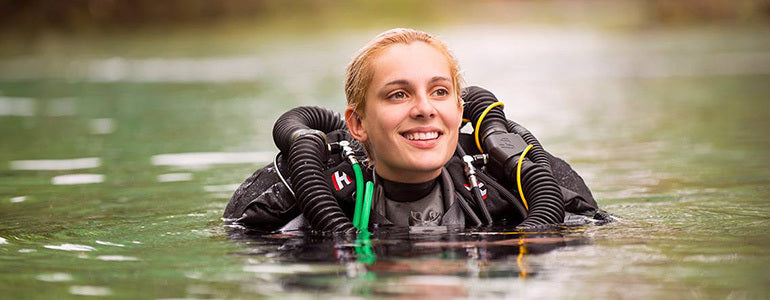
How to take your diving to the next level
So, you’ve been diving for a while now and have noticed that you’re itching for something new or more challenging – that’s a sign it’s time to take your diving to the next level. We talk to 25-year-old technical diver Gemma Smith – the first woman to dive the ancient Antikythera shipwreck – about how to step up your diving.
© Nina Baxa
Before Gemma Smith started diving when she was 17 she’d been into a number of extreme sports. “Then I discovered scuba diving, and that was that!” she says. We caught up with her a day before she set off on an intense three months of diving, including cave diving in Florida, mine diving in Newfoundland and shark diving in the Bahamas. Here are her 7 pointers for how to take your diving to the next level.
It’s not just about depth or difficulty
Even though I'm known as a technical and re-breather diver some of my best dives have been on a single tank and in 10 m of water! Diving with silversides in Grand Cayman was truly out of this world, yet I never went below a few meters. Having said that, cave diving is where my heart is. When you're on a re-breather 2 km into a cave, gliding along on a DPV (diver propulsion vehicle), I'm not sure anything can top that.
“Some of my best dives have been on a single tank and in 10 m of water!”
Build your motivation
One of the things I like most about diving is there’s always something new you can challenge yourself with. As long as you have the motivation and dedication to pursue different avenues and try new things, you'll never get bored and never feel like you're not improving.
© Nina Baxa
Patience and hard work are mandatory
The first thing to remember is to be patient. Taking your diving to the next level won't come quickly, it won't be easy, but it will totally be worth it. You've got to be prepared to give up a lot, and to work hard.
© J. Dan Wright
It’s all about the people
You will also need to make the effort to meet people. The diving world is really small, and – especially with the expedition scene – it helps if you know the guys involved. You need to try to stand out, and that requires effort. Spend the money and train with the best people out there. I've trained with some truly amazing instructors; Martin Robson, Rich Walker, Paul Toomer, Ian France. The things I learned from them have allowed me to take my diving to the next level.
“Spend the money and go to train with the best people out there.”
Change in outlook
Changing how you see your diving is really important if you want to take it further. I love my diving, and I'm so glad I've chosen it as my career, but nonetheless it's my job, and I treat it as such. I don't see it as my hobby.
© J. Dan Wright
Make an investment
You also need to realise that if you want to advance your diving it will require a big investment, both financially and in terms of time. I always compare it to university. I chose not to go, but I've invested the same time and money in diving. You need that mind-set I think if you want to succeed.
“I always compare it to university. I've invested the same time and money in diving.”
Practice, practice, practice
Practice. On every single dive you need to practice skills, preferably two. So many people do courses, and then never practice any of the skills they learned. Have fun, enjoy it, but take it seriously. It's the only way to improve.© J. Dan Wright
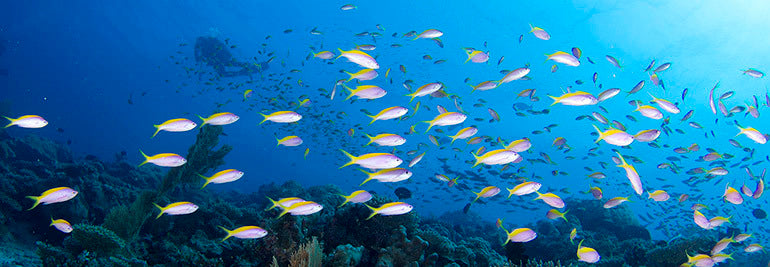
BRAD HOLLAND TAKES OVER @SUUNTODIVE FOR A WEEK
Photographer and full-time traveller Brad Holland takes over and hosts Suunto’s @suuntodive Instagram account for a week starting today. Follow and enjoy Brad's photography!
“I am happiest when I don’t know what day it is, what time zone I am in or how long I’ll be there. Home is where my gear is... which stays in world tour status from the West Pacific to Mexico, the Middle East and Africa with work bases in Yap, Micronesia and Central America,” says the photographer who originally comes from Los Angeles, California.
Brad shoots a Canon 7D MkII and Ikelite Underwater Systems combination and favors his wide-angle lenses. His photographic missions include telling people about Yap, a small island state in the Pacific that nobody knows about, supporting local marine research and conservation projects as well as a volunteering on a typhoon disaster relief operation in the remote outer islands of Yap State. “Everything else falls under good times and living in the moment,” Brad declares.
Brad can be found leading photo dives at the Manta Ray Bay Resort, shooting the local culture in Yap or on travel adventure somewhere in the world throughout the year.
@bradlifestyle will be taking over @suuntodive Instagram account for a week starting April 5th.
Follow and enjoy Brad's photography!
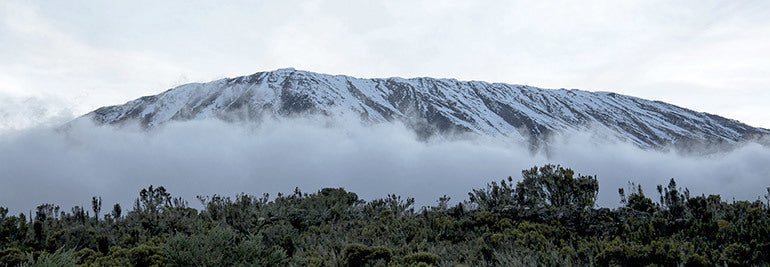
Mt. Kilimanjaro: More to Explore
“Mount Kilimanjaro is more than it’s famed snows, more than it’s iconic, statuesque crater that commands the landscape. It is more than the tallest “trekkable” mountain in the world. To hike Kilimanjaro is to be encapsulated into evolving ecosystems, from tropical rainforest to snow-covered peaks in a few days making for unique experience in our natural world,” describes adventurer Matt Mitchell.
There are seven established climbing routes on Kilimanjaro. To trek a different route to the summit is to live a separate and entirely unique experience. In search of true wilderness, we chose Rongai, the least trafficked route and the only one starting from the North, along the Kenyan border. It is the only trek that includes the entire spectrum of habitats in Kilimanjaro’s vast ecosystem, though you have to go out of your way to find it. After a two-hour drive from the park’s main gate, winding through hectic, dusty villages, we arrived at the trailhead. Our journey began in a wild, tropical rainforest, it was difficult to believe that in a few days we would be immersed in freezing cold and burning sun of arctic conditions.
Before we left for Tanzania we plotted the route to my Suunto Traverse GPS watch, helping us to navigate and identify POIs (camps and highlights) as well as and track our altitude and gain each day.
Kilimanjaro is a busy mountain year round on most routes, so when we found ourselves trekking alone we were surprised, and delighted. We felt like we had the mountain to ourselves, free to move at our pace and simply appreciate our surroundings. The mountain itself was pristine, even at camps debris or evidence of hikers was rarely seen.
Giant, jagged crevasses created by lava flows and home to streams from another time lay hidden behind wild and unwieldy bushes. Throughout the forest and heather our path was enveloped in thick rolling fog. Wide, sloping caves that were once shelter, now help to mark the trail.
Unlike routes from the south, clear views of Kibo are frequent above 3500 m on Rongai. While our previous days were filled with fog and mist, the greyness gave way to clear and intense days in the sun. Our nights got much colder above the clouds and we started to feel the thinning air as we moved toward the alpine desert. Our only company was a pair of white-necked ravens who followed us for two days and nights.
Kilimanjaro is not simply its dominant and easily identifiable volcanic cone (Kibo), with its graceful lines. In fact Kilimanjaro is made up of three volcanoes- Kibo, Mawenzi and Shira. Kibo remains dormant, the others extinct. As we traversed alpine desert in scorching 37 degree sun, the imposing, jagged edifice of Mawenzi appeared. Hans Meyer Peak is its highest point at 5149 m (third highest point in Africa) and is separated from Kibo by 6 km of baron desert known as ‘The Saddle.’
We arrived at Kibo Huts (4700 m) in the afternoon of our forth day, with a world already below us. We were paying for each moment at this altitude and higher, so at midnight under steady snowfall we climbed towards the stars. There was still a mountain above us, and all we could see were bobbing headlamps and utter darkness. We trudged across steep, scree switch-backs (up to 45 degree) for 5 hours, glancing only occasionally at the horizon for the slightest hint of the day to come. Breathing becomes more difficult with each step, relentlessly testing all faculties. Even simple recognition is not a given at this altitude. As we scrambled to the top of Gilman’s Point and beyond the grandeur of Kibo is startling, its glaciers, sheer cliffs and vast expanses are unforgettable.
There is nothing like feeling the day’s first light atop a mountain, invigorates your senses, and brings your body back to life. The streams of clouds and color and light made us feel like we could see all of Africa.
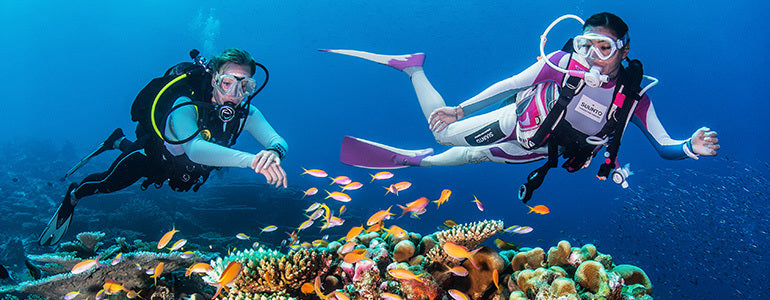
A pro diver’s essential tips for newbie divers
Teaching the joy of diving is Marco's passion. © atmosphereresorts.com
Diving isn’t an extreme sport
The classic newbie misunderstanding is thinking that diving is an extreme sport. Often they think it’s a very physical sport, but the opposite is true; diving is a very relaxed activity. Water is much denser than air, and that’s why we need to move slowly and be streamlined all the time. Once I taught a yoga teacher and after the dive she said, “being underwater is similar to a yoga class”.
Different strokes for different folks
Every person is different. One person, for example, needs much more time to get the buoyancy right, while another needs less (buoyancy is difficult in the beginning, but gets easier with practice). It’s important to be patient and to find an instructor you’re comfortable with so you can relax.
© Bo Mancao
Get in shape
You don’t need to train specifically to become a diver, but it’s helpful to be in good physical shape and a strong swimmer. Before you start your course, you need to sign a medical questionnaire to make sure you are fit to dive.
One step at a time
Don’t rush in and buy all the gear immediately. Give it time to make sure you really want to commit to diving. I highly recommend buying your own dive mask, however, because every face shape is different and it’s important to be comfortable. You can use it for snorkeling, too. If you decide diving is for you, then it makes sense to buy your personal dive gear. But go step by step.
© Bo Mancao
Follow the stars
Choosing the right dive center to learn at is important. It’s best to find a five star PADI center. Taking an online diving course is a great idea too so when you finish your studies online you can focus on the practical side of things.
Dive into open water
So, you’re 100% into diving! Time to complete an open water diving course! If you finish the theory online beforehand, an open water diving course can be completed in two to three days. With the theory included, it takes between three to four days. Don’t rush it. The instructor needs to make sure the students are ready. Following this is the advanced open water diver course.
Click to see the new Suunto Zoop Novo Blue*!
© Bo Mancao
Find a dive buddy
You should never dive alone. It’s safer and more fun to have a dive buddy, someone you trust, and whose equipment you’re familiar with. Diving is a very social activity so finding a buddy won’t be hard. You usually dive with someone you meet on a boat, at a resort, or in a dive shop. It’s important you speak about the dive and equipment before you take the plunge together.
Working with fear
Experiencing some level of fear is a very common experience for newbie divers. I was really afraid when I did my open water course. That’s when a good instructor can make all the difference. If the instructor is calm and gives the student time to adjust – because his or her brain is overloaded with new information – they usually work through it.
Marco won't be giving up his day job anytime soon. © atmosphereresorts.com
Keep diving!
Most people dive just for fun so they mainly dive when they’re on vacation. How often you dive depends on your personal goals, but diving once or twice every six months or year is a good idea so you avoid losing skills and familiarity.
*Suunto has just released the Zoop Novo Blue, a dive watch perfect for beginner divers or people seeking new adventures. Click here for more info about this simple to use dive computer.
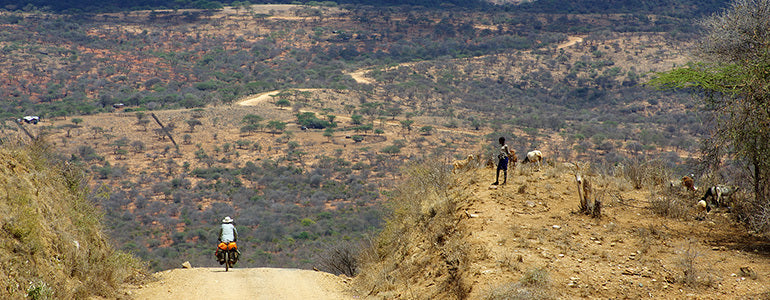
Meet the nomad who has cycled around the globe four times
Pierre Bouchard began cycle touring in 1990 and has since travelled all over the world, covering the distance of four loops of the planet. In this first of three instalments* about the “Nomads” we asked him what he’s learned.
© nomadesxnomades.com
Pierre Bouchard’s life on the road began with sage advice from a philosophy professor; “the ideal would be to travel the world and account for it,” the professor suggested during a lecture. Then a philosophy student, Pierre says as soon as he heard this his “mind flew right out the window”.
Shortly after, he dropped out of university and set out to study what René Descartes called “the great book of the world”. He pedalled more than 71,000 km through 18 countries in the following seven years. His partner Janick Lemieux joined him on the road in 1997 and together they’ve cycled through more than 60 countries in the Americas, Europe, Asia and Oceania – and currently Africa.
Their expeditions are about far more than seeing sites and sampling foreign food, however. The couple approach their journeys as acts to build understanding and solidarity between distant cultures. They are particularly interested in remote and nomadic cultures and have given hundreds of lectures about their findings and experiences.
© nomadesxnomades.com
“By sharing what we learn, and by informing our hosts on the road about our own culture, we contribute to a sense of humanhood which is the basis for genuine solidarity!” Pierre says. “We‘ve learned that we all have the same needs and are all subjected to the same existential conditions, so why not help one another?”
“People are very curious and somehow don’t feel threatened by strangers on loaded bikes. They come close, greet us and inquire about the obvious journey we’re on which often triggers a reflex of human solidarity where invitations for a drink, meal, shower and shelter fuse.”
© nomadesxnomades.com
Through 1999 to 2009, the couple circumnavigated the Pacific Rim, riding along its tectonic faults and ridges, pedalling from one active volcano to the next. Travelling clockwise from Vancouver, they cycled about 60,000 km in six years, using 300 volcanoes to create their itinerary and hiking to, around or to the summit of around 60.
“One of the advantages of having a theme to explore is that they take you to places you would never imagine – you don't usually think of Vanuatu or the Solomon Islands as your typical bike touring destinations, but they rock,” Pierre says. “The Ring of Fire quest took us to some of our planet's wildest spots and warmest people.”
© nomadesxnomades.com
Pierre and Janick are currently cycling through Tanzania, having made it more than half way through their 35,000 km NOMADS² cycle tour. The three-year expedition is focused on deepening their understanding of the nomadic way of life. Starting in Norway, they cycled north to Lapland, and then south down through Eastern Europe, the Middle-East and the east of Africa. Along the way they have contacted various nomadic peoples, such as the Sami in Scandinavia, the Roma in Europe, and other tribes, seasonal herders and hunter-gatherers. After cycling 21,000 km in 21 months, they’re pausing their journey shortly in Tanzania, and will return after a 15 month break to complete the journey north up the west of Africa to Morocco.
© nomadesxnomades.com
“We have learned that being a nomad is becoming more and more difficult because, due to the population explosion, the world is getting crowded,” Pierre says. “The race to exploit natural resources by the more powerful often pushes nomads out of their natural territories to which they often have no legal deeds. There is also development playing a role, with new school-going nomad generations often not willing to continue to live simply like their parents and ancestors. For now, nomadism is fast disappearing.”
“Nomads are in symbiosis with nature and for this reason, it would be good for the planet if more of us were to adopt the way of the nomads. They definitely inspire us to have a lower and sustainable impact on the environment and its resources!”
*Stay tuned for our second and third stories about the Nomads, and find out which countries in the world are the most cycle-friendly!














































































